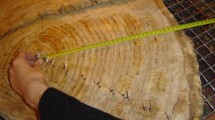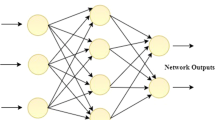Abstract
The aim of this study is to propose an alternative methodology to classify wood species using the first (DTG), second (2DTG), and third (3DTG) derivatives of the thermogravimetric curves (TG). Accordingly, the main contribution of this new procedure consists on classifying materials (wood) taking into account the mass loss rate and acceleration with respect to temperature. In our research, each TG curve is firstly smoothed using the local polynomial regression estimator, and the first, second, and third derivatives are estimated. The application of the local polynomial regression estimator provides a reliable way to obtain the TG derivatives, overcoming the noise problem in the TG derivative estimation. Then, using these estimated curves, the different wood classes are discriminated employing a nonparametric functional data analysis (NPFDA) technique, based on the Bayes rule and the Nadaraya-Watson regression estimator, and also novel functional generalized additive models (GAM). The latter allows to classify materials using simultaneously more than one type of thermal curves. The results are compared with those obtained using classical and machine learning multivariate supervised classification methods, such as Linear discriminant analysis, Quadratic classification, Naïve Bayes, Logistic regression, \(k\) Nearest neighbors, Neural networks, and Support vector machines. A regression model consisting of the mixture of the first derivatives of four generalized logistic components, one per principal wood constituent (water, hemicellulose, cellulose, and lignin), is applied to fit the DTG curves. The resulting 16 parameters from this fit characterize each curve and are used as datasets to apply the multivariate supervised classification methods. The use of the TG derivatives jointly with the TG curves has proved to be an optimal discriminating feature, when the new functional GAM techniques are employed.






Similar content being viewed by others
Abbreviations
- DTG:
-
First derivative of the thermogravimetric curve
- 2DTG:
-
Second derivative of the thermogravimetric curve
- 3DTG:
-
Third derivative of the thermogravimetric curve
- TG:
-
Thermogravimetric curve
- NPFDA:
-
Nonparametric functional data analysis
- GAM:
-
Generalized additive models
- FTR:
-
Fourier transform Raman
- NN:
-
Neural networks
- \(k\)-NN:
-
\(k\) nearest neighbor
- SVM:
-
Support vectors machines
- PDSC:
-
Pressure differential scanning calorimetry
- LDA:
-
Linear discriminant analysis
- NBC:
-
Naïve Bayes classifier
- FDA:
-
Functional data analysis
- K-NPFDA:
-
Nonparametric functional data analysis based on kernel methods
- IRLS:
-
Iteratively reweighted least-squares
- ASE:
-
Average squared error
- MDS:
-
Multidimensional scaling
- GLM:
-
Generalized linear model
References
Lewis IR, Daniel NW, Chaffin NC, Griffiths PR. Raman spectrometry and neural networks for the classification of wood types-1. Spectrochim Acta A, Mol Biomol Spectrosc. 1994;50:1943–58.
Yang H, Lewis IR, Griffiths PR. Raman spectrometry and neural networks for the classification of wood types. 2. Kohonen self-organizing maps. Spectroc Acta Part A. 1999;55:2783–91.
Piuri V, Scotti F. Design of an automatic wood types classification system by using fluorescence spectra. IEEE Trans Syst Man Cybern Part C-Appl Rev. 2010;40:358–66.
Mallik A, Tarrío-Saavedra J, Francisco-Fernández M, Naya S. Classification of wood micrographs by image segmentation. Chemometrics Intell Lab Syst. 2011;107:351–62.
Bremananth R, Nithya B, Saipriya R. A wood species recognition system. Int J Intell Syst Technol. 2009;4:54–60.
Wang HJ, Zhang GQ, Qi HN. Wood recognition using image texture features. PLoS One. 2013;8(e76):101.
Rojas JAM, Alpuente J, Postigo D, Rojas IM, Vignote S. Wood species identification using stress-wave analysis in the audible range. Appl Acoust. 2001;72:934–42.
Budrugeac P, Emandi A. The use of thermal analysis methods for conservation state determination of historical and/or cultural objects manufactured from lime tree wood. J Therm Anal Calorim. 2010;101:881–6.
Cavallaro G, Donato DI, Lazzara G, Milioto S. A comparative thermogravimetric study of waterlogged archaeological and sound woods. J Therm Anal Calorim. 2011;104:451–7.
Francisco-Fernández M, Tarrío-Saavedra J, Mallik A, Naya S. A comprehensive classification of wood from thermogravimetric curves. Chemometrics Intell Lab Syst. 2012;118:159–72.
Tarrío-Saavedra J, Naya S, Francisco-Fernández M, López-Beceiro J, Artiaga R. Functional nonparametric classification of wood species from thermal data. J Therm Anal Calorim. 2011;104:87–100.
Tarrío-Saavedra J, Francisco-Fernández M, Naya S, López-Beceiro J, Artiaga R. Wood identification using pressure DSC data. J Chem. 2013;27:475–87.
Wendlandt WW, Gallagher PK. Instrumentation. In: Turi EA, editor. Recent advances in functional data analysis and related topics. New York: Academic Press; 1981.
Prime RB, Bair HE, Gallagher PK, Riga A. Thermogravimetric analysis (TGA). In: Menczel JD, Prime RB, editors. Thermal analysis of polymers fundamentals and applications. San José: Wiley; 2009.
Diblasi C. Modeling chemical and physical processes of wood and biomass pyrolysis. Prog Energy Combust Scil. 2008;34:47–90.
Gronli MG, Várhegyi G, Blasi C. Thermogravimetric analysis and devolatilization kinetics of wood. Ind Eng Chem Res. 2002;41:4201–8.
Sebio-Puñal T, Naya S, Lopez-Beceiro J, Tarrio-Saavedra J, Artiaga R. Thermogravimetric analysis of wood, holocellulose, and lignin from five wood species. J Therm Anal Calorim. 2012;109:1163–7.
Alén R, Kuoppala E, Pia O. Formation of the main degradation compound groups from wood and its components during pyrolysis. J Anal Appl Pyrolysis. 1996;36:137–48.
Gašparovič L, Koreňová Z, Jelemenský L. Kinetic study of wood chips decomposition by TGA. In: Proceedings 36th international conference of SSCHE. Tatranské Matliare, World Scientific; 2009, vol 178, pp. 1–14.
Müller-Hagedorn M, Bockhorn H, Krebs L, Müller U. A comparative kinetic study on the pyrolysis of three different wood species. J Anal Appl Pyrolysis. 2003;68–69:231–49.
Raveendran K, Ganesh A, Khilar KC. Pyrolysis characteristics of biomass and biomass components. Fuel. 1996;75:987–98.
Roberts AF. A review of kinetics data for the pyrolysis of wood and related substances. Combust Flame. 1970;14:261–72.
Wang S, Wang K, Liu Q, Gu Y, Luo Z, Cen K, Fransson T. Comparison of the pyrolysis behavior of lignins from different tree species. Biotechnol Adv. 2009;27:562–7.
Yang H, Yan R, Chen H, Lee DH, Zheng C. Characteristics of hemicellulose, cellulose and lignin pyrolysis. Fuel. 2007;86:1781–8.
Mohan D, Pittman JCU, Steele PH. Pyrolysis of wood/biomass for bio-oil: a critical review. Energy Fuel. 2006;20:848–89.
Dai J, Liu N, Shu L. Applicability of bi-pseudo component separated-stage model for decomposition of lignocellulosic materials in air at multiple heating rates. J Therm Anal Calorim. 2011;104:983–90.
Cuevas A, Febrero M, Fraiman R. Linear functional regression: the case of fixed design and functional response. Can J Stat. 2002;30:285–300.
Cuevas A, Febrero M, Fraiman R. An anova test for functional data. Comput Stat Data Anal. 2004;47:111–22.
Ferraty F, Romain Y. The Oxford handbook of functional data analysis. Oxford: Oxford University Press; 2010.
Ferraty F, Vieu P. The functional nonparametric model and application to spectrometric data. Comput Stat. 2002;17:545–64.
Ferraty F, Vieu P. Curves discrimination: a nonparametric functional approach. Comput Stat. 2003;44:161–73.
Ferraty F, Vieu P. Nonparametric functional data analysis: theory and practice. New York: Springer-Verlag; 2006.
Locantore N, Marron JS, Simpson DG, Tripoli N, Zhang JT, Cohen KL. Robust principal component analysis for functional data (with discussion). Test. 1999;8:1–74.
Naya S, Francisco-Fernández M, Tarrío-Saavedra J, López-Beceiro J, Artiaga R. Application of functional data analysis to material science. In: Ferraty F, editor. Recent advances in functional data analysis and related topics. Berlin Heilderberg: Springer-Verlag; 2011.
Ramsay JO, Silverman BW. Functional data analysis. New York: Springer-Verlag; 2005.
Tarrío-Saavedra J, Naya S, Francisco-Fernández M, López-Beceiro J, Artiaga R. Application of functional ANOVA to the study of thermal stability of micro-nano silica epoxy composites. Chemometrics Intell Lab Syst. 2011;105:114–24.
R Development Core Team. R: a language and environment for statistical computing. R Foundation for Statistical Computing, Vienna, Austria; 2011. http://www.R-project.org
Febrero M, Oviedo M. fda.usc: The functional package: summary information. R package version 1.0; 2009.
Febrero-Bande M, González-Manteiga W. Generalized additive models for functional data. Test. 2013;22:278–92.
Wood S. Generalized additive models: an introduction with R. Boca Raton: Chapman and Hall/CRC; 2006.
Fisher RA. The use of multiple measurements in taxonomic problems. Ann Eugen. 1936;7:179–88.
Hill T, Lewicki P. Statistics methods and applications. Tulsa: StatSoft; 2007.
Fix E, Hodges JL. Discriminatory analysis, nonparametric discrimination: consistency properties. USAF School of Aviation Medicine, Randolph Field, Texas Technical Report 4; 1951.
Vapnik V. Statistical learning theory. New York: Wiley; 1998.
Ripley BD. Pattern recognition and neural networks. Cambridge: Cambridge University Press; 1996.
López-Granados F, Peña Barragán JM, Jurado-Expósito M, Francisco-Fernández M, Cao R, Alonso-Betanzos A, Fontenla-Romero O. Multispectral classification of grass weeds and wheat (Triticum durum) using linear and nonparametric functional discriminant analysis and neural networks. Weed Res. 2008;48:28–37.
Wehrens R. Chemometrics with R. multivariate data analysis in the natural sciences and life sciences. New York: Springer-Verlag; 2011.
Wand MP, Jones MC. Kernel smoothing. London: Chapman and Hall; 1995.
Ruppert D, Sheather SJ, Wand M. An effective bandwidth selector for local least squares regression. J Am Stat Assoc. 1995;90:1257–70.
Acknowledgements
This research has been supported by the Spanish Ministry of Science and Innovation, Grant MTM2008-00166 (ERDF included) and Grant MTM2011-22393. The authors wish to express special thanks to Manuel Oviedo for his valuable comments.
Author information
Authors and Affiliations
Corresponding author
Rights and permissions
About this article
Cite this article
Francisco-Fernández, M., Tarrío-Saavedra, J., Naya, S. et al. Classification of wood using differential thermogravimetric analysis. J Therm Anal Calorim 120, 541–551 (2015). https://doi.org/10.1007/s10973-014-4260-y
Received:
Accepted:
Published:
Issue Date:
DOI: https://doi.org/10.1007/s10973-014-4260-y




